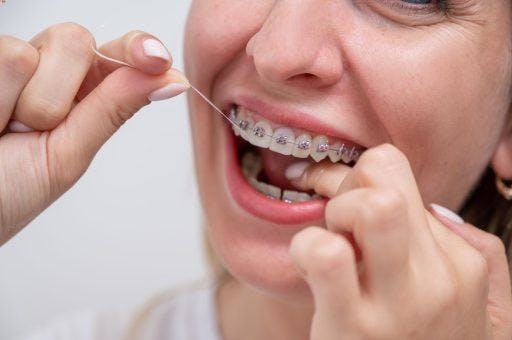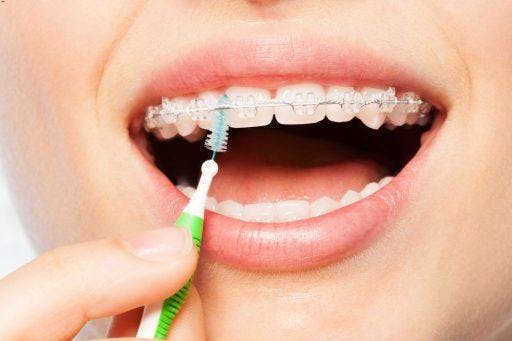For many, learning how to floss effectively is challenging enough without worrying about orthodontic devices.
If you’re wearing braces or similar fixed appliances, flossing can be awkward and take quite a bit of time. Though you might be tempted to skip this part of your dental routine, especially when busy, your later self will thank you if you keep up your flossing habit. Having orthodontic devices makes flossing even more important to keep your teeth healthy.
Flossing plays a critical role in your oral health maintenance – just like brushing your teeth. It’s the best way to clean the spaces between teeth where food particles and bacteria sneak in. That buildup can lead to issues like gum disease and tooth decay.
How to floss while wearing orthodontic devices – A step-by-step guide
How do you get around fixed appliances like braces or permanent retainers? What about clear aligners? Thankfully, the process becomes less daunting with the right techniques and tools.
Removable appliances are easy to pop off when it’s time to floss. Devices like ClearCorrect aligners allow you to go about your routine as usual, making them a good choice if you want to address misalignment but have concerns about cleaning between your teeth while in treatment.
If you’re wearing fixed appliances, the attached brackets, wires, and elastics can create more opportunities for bacterial growth. They also make teeth cleaning harder since you must adjust your methods to work around them.
Here’s a step-by-step guide on how to floss when wearing fixed appliances:
- Take a piece of dental floss long enough to wrap each end around one of your index fingers while flossing. The Australian Society of Orthodontists (ASO) suggests a length of at least 18 centimetres. You can use as much as 30 to 45 centimetres if it gives you more control.
- Slip one end of the floss between your teeth and the wire. If you’re using a floss threader, this is when to bring it out. Pull your floss through the eye of the threader, then insert its pointy end under your braces’ wire.
- Wrap the ends of the floss around your index fingers, using your thumbs to assist with movement. Curve the string floss around the side of each tooth to form a loop.
- Rub the floss along the side of each tooth using a gentle up-and-down motion. Make sure to reach just under the gumline to remove any stubborn plaque from the area. But be careful not to snap, force, or drag the floss; otherwise, you can cut or bruise sensitive gum tissue.
- Floss each tooth on both sides until you’ve cleaned all your teeth.
- Brush your teeth. Doing this after flossing makes brushing more effective since toothpaste can now reach the gaps between your teeth without obstruction.
Types of floss
Depending on your needs, your orthodontist may recommend different types of flossers to improve your dental hygiene routine. Common types of flossers include:
- string floss, waxed or unwaxed
- dental floss picks, also known as flossettes
- interdental brushes
- water flossers, electric flossers or irrigators
Orthodontists often recommend string floss and interdental brushes if you use fixed appliances. Moving flossettes around brackets and wires can be challenging, and while irrigators can help remove larger particles of food from around braces, they are less effective for removing plaque. Meanwhile, string floss and interdental brushes allow more manoeuvrability.
Whichever type of flosser you use, it’s a good idea to ask your dentist or orthodontist to demonstrate how to floss so you don’t risk damaging your gums, teeth, or orthodontic device.
Tooth-flossing tips for fixed and removable appliances

Do you still struggle with flossing properly regardless of your orthodontic device? Here are a few tips to help you get it right.
Use waxed floss.
Waxed and unwaxed floss both get the job done. However, the former might work better for those with braces or tightly packed teeth. The thin layer of wax coating the floss helps it glide more smoothly through the spaces between your teeth and prevents fraying or shredding during use. Waxed floss is also less abrasive on sensitive gums.
When you have braces, sliding the floss between wired teeth is like threading a needle – a time-consuming headache. So, pick up an orthodontic floss threader to minimise frustration. It’ll allow you to pull the floss through your teeth and reach your gumline despite all the wires.
Try alternative tools.

Using dental floss with orthodontic appliances can be tricky. But don’t worry, you have other options, especially if you’re just learning to live with braces or similar devices.
Interdental brushes look like miniature bottle cleaners with tiny, soft-bristled brush heads. They’re a cinch to manoeuvre under the tight wires of braces.
Electric flossers, also known as oral irrigators, are a slightly higher-tech solution. They direct steady, pressurised pulses of water between the teeth, rinsing away food particles, plaque, and other debris. However, they may be less effective against stubborn plaque, especially around brackets and elastics. A backup flosser could be a wise idea.
Ask for a demonstration.
Ask your dentist or orthodontist to show you how to floss at your next checkup. After all, who better to teach you how to floss than the experts?
Your dentist can show you the step-by-step process of flossing with orthodontic devices and explain the purpose of particular techniques. You can show them what you’ve been doing on follow-up visits and ask for tips to improve.
Keep practising.
The only way to get better at flossing is to keep at it. How many times a day should you floss? The Australian Dental Association (ADA) recommends cleaning between teeth at least once daily, but those with gum disease may need to do it more often. That means you have plenty of opportunities to refine your approach!
Floss even if your gums bleed at first.
Do you hesitate to floss because your gums bleed? The ADA emphasises that this shouldn’t happen with healthy gums. If flossing leads to bleeding, you may be dealing with inflammation caused by plaque buildup. That’s a sign you should be flossing more consistently and observing better gum care.
Eventually, your gums will heal, making the experience less painful. But if you notice continued bleeding, consult your dentist.
Knowing how to floss correctly is an invaluable skill for proper oral care, especially when wearing orthodontic appliances like ClearCorrect aligners. Follow these tips, and you’ll be flossing like a pro in record time.
References:
Cleaning between the teeth | Teeth.org.au | How To Floss Well. (n.d.). Teeth.org.au.
Flossing with Braces. The Orthodontists.
How to use dental floss with braces. Orthodontics Australia.



